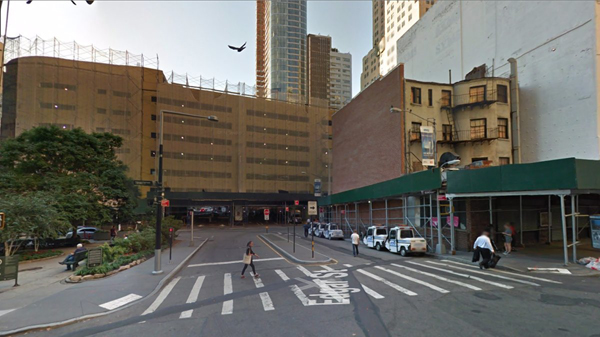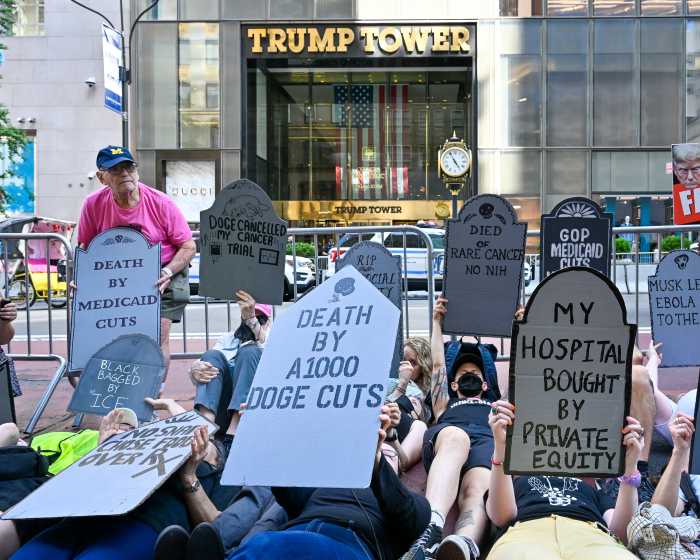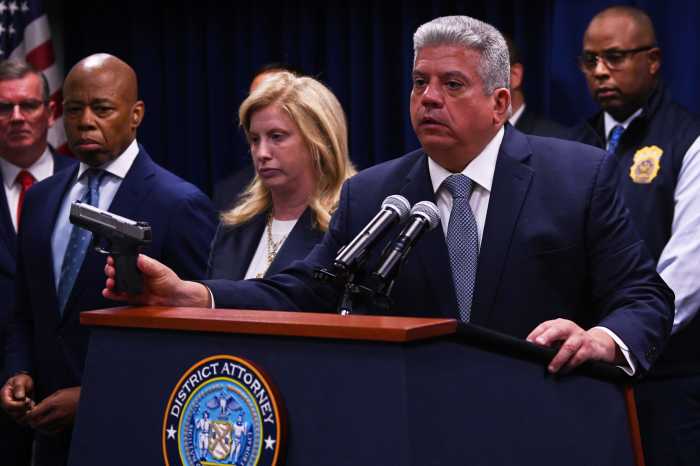
With a new elementary school planned for the site on the right, there’s a growing push to close Edgar St. and make it part of the plaza on the left to give students at the upcoming Trinity Place School more outdoor recreational space.
BY COLIN MIXSON
City bureaucrats with the Department of Transportation are telling locals that the safety of schoolkids on the streets around the upcoming Trinity Place School isn’t their problem, and any traffic studies or changes with have to funded by the developer.
Parents and school advocates are flabbergasted that the city would suddenly shift the responsibility to a private company that now has little incentive to make changes — which they see as a short-sighted recipe for tragedy.
“[The developer] can just build it the way it is, and then kids will get hit by cars, and then the city will fund the change — except it will cost more money at that point, and someone will already have gotten hurt,” said Eric Greenleaf, a member of the Lower Manhattan School Overcrowding Task Force.
The city has purchased property within the residential development helmed by Trinity Place Holdings at 77 Greenwich Street as a site for a 476-seat elementary school, which is expected to open sometime in 2022.
But the narrow sidewalks surrounding the future school — and the site’s location adjacent to the bustling exit of the Brooklyn-Battery Tunnel — has led community members and local lawmakers to request a number of traffic changes in the area to reduce risks to students. These include closing a west-bound lane on Edgar Street between Greenwich Street and Trinity Place to accommodate a sidewalk extension that would provide a plaza where students and faculty can congregate without the threat of getting hit by a speeding bus, according to Community Board 1’s youth committee co-chair and member of the overcrowding task force.
“All they have is this roughly 650-square feet courtyard — that’s tiny and it’s not adequate for drop off and pickup for the school,” said Tricia Joyce, a member of Community Board 1 and advocate of creating the so-called Edgar Street Pedestrian Plaza. “A plan has to be in place by the time this opens.”
But bureaucrats at the city’s transit agency have refused even to fund the study required for the agency to weigh in on the proposal, instead saying its up to the developer to not only foot the bill for a feasibility test, but also fund any subsequent work, according to spokeswoman Alana Morales.
“As is typical with new developments, a traffic study would need to be conducted by the developer,” said Morales. “Any costs associated with traffic changes would be the responsibility of developer [or] property owner.”
Usually, the city would dangle necessary zoning changes or the promise of additional development rights in front of builders to induce any desired pro-bono spending on the developer’s part.
As it stands, however, Trinity Place Holdings doesn’t require any further permissions or permits from the city to complete construction of the largely residential tower, meaning DOT appears content to rely purely on the developer’s sense of charity, and the consequences could be dire, Greenleaf said.
“It sounds as though the DOT is being intransigent,” said Greenleaf. “I don’t really understand that. If the school is being built as planned, there will be tons of traffic problems; there could be injuries or worse.”
Local lawmakers, including state Sen. Daniel Squadron, agree it would be nice if the developer chipped in money for the study, but about the only party saying the responsibility doesn’t ultimately fall on DOT’s shoulders is DOT itself.
“It would be great if the developer picked up the tab, but at the end of the day, that can’t be an excuse for nothing to happen,” said Squadron spokesman Zeeshan Ott.
Assemblywoman Yuh-Line Niou condemned the city for passing the buck on a process that can take considerable time, and should begin as quickly as possible.
“Finger pointing on who is responsible for funding a study only delays the speed at which we can deliver the peace of mind of school safety to Lower Manhattan families,” Niou said.
As it is, the city has track record of waiting for tragedy, and then taking action.
In Tribeca, the city waited until after a child was hit by a speeding cab crossing Greenwhich Street at Duane Street in 2011 to install a much-needed traffic light, despite repeated requests for improvements from parents and safety advocates.




























